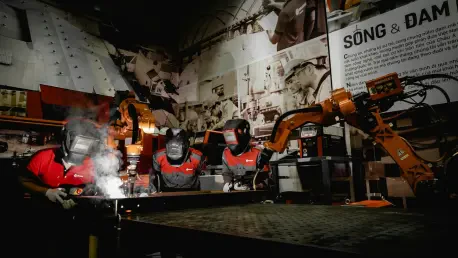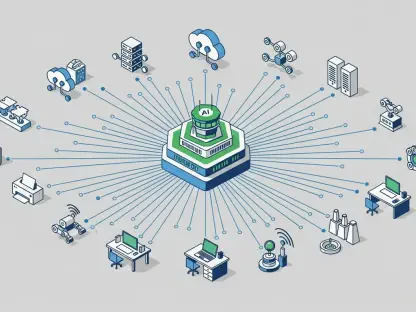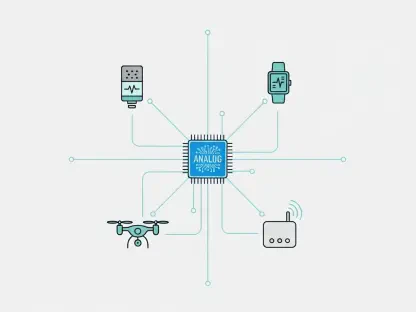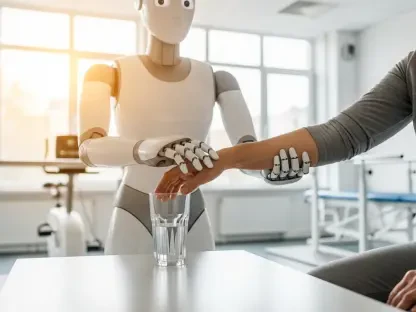AJIn the sprawling industrial hubs of China, often hailed as the “factory of the world,” a profound transformation is underway that could redefine global manufacturing standards, reshaping how goods are produced across various sectors. Factories are no longer just assemblies of human labor but are evolving into high-tech ecosystems where industrial robots work tirelessly alongside their human counterparts. This shift, driven by a blend of economic necessity and strategic ambition, is positioning China to maintain its dominance in production amidst rising challenges. From the bustling plants of Guangzhou to the policy corridors of Beijing, the integration of automation is not merely a trend but a fundamental restructuring of how goods are made. This rapid adoption of robotics—evidenced by a surge to over 1.7 million industrial robots in operation—places China as a frontrunner in robot density, trailing only behind South Korea and Singapore. The implications of this change ripple through employment, productivity, and global trade, setting the stage for a new era in manufacturing.
The Role of Government Policy in Automation
Driving the Robotics Boom
China’s ascent as a leader in industrial automation owes much to deliberate and robust government intervention, particularly through the “Made in China 2025” initiative. Launched a decade ago, this strategic plan seeks to elevate the nation’s manufacturing capabilities by focusing on high-end technologies, with robotics at the forefront. Through a combination of subsidies, tax rebates, and financial incentives, the cost of acquiring robots has become significantly more manageable for factory owners. The result is a booming domestic robotics industry, with production numbers soaring to nearly 370,000 units in just the first half of the current year, marking a substantial increase compared to previous periods. This policy-driven push not only fosters technological adoption but also ensures that China remains a competitive force in global markets by reducing reliance on foreign tech and nurturing homegrown innovation.
Beyond the numbers, the government’s role extends to creating an ecosystem that supports automation at every level of manufacturing. Local authorities often collaborate with enterprises to tailor solutions that address specific industry needs, ensuring that even small and medium-sized factories can access robotic technologies. High-level endorsements, such as statements from top leadership emphasizing the critical importance of manufacturing to national stability, further reinforce this commitment. This comprehensive approach has catalyzed a cultural shift within the industry, where upgrading to automated systems is seen as an imperative rather than an option. The ripple effects are evident in factories across the country, where the sight of robotic arms and automated vehicles is becoming commonplace, symbolizing a national resolve to lead in the next industrial revolution.
Shaping Industry Standards
Government policies are not just about increasing robot numbers; they are also setting new benchmarks for manufacturing standards across China. By integrating automation into national development goals, authorities are pushing companies to adopt cutting-edge practices that enhance quality and efficiency. This includes mandating or encouraging the use of smart technologies that can communicate and coordinate with robotic systems, creating seamless production lines. Such measures ensure that Chinese factories are not merely keeping pace with global competitors but are often surpassing them in terms of technological sophistication. The focus on high-end manufacturing also means that industries are diversifying, moving beyond traditional goods to more complex, value-added products that require precision only robots can consistently deliver.
Moreover, these policies are fostering a competitive environment where innovation thrives. State-backed research and development programs are incentivizing the creation of more advanced, cost-effective robots tailored to local needs. This has led to a proliferation of domestic manufacturers who are not only supplying the Chinese market but are beginning to export their technologies, challenging established global players. The emphasis on automation is also reshaping supply chains, as factories become more self-reliant and less dependent on human labor fluctuations. As a result, the landscape of Chinese manufacturing is being redrawn, with automation becoming a cornerstone of industrial identity and a key driver of economic resilience in an increasingly volatile global economy.
Economic and Labor Challenges Fueling Change
Addressing Workforce Shortages
The rapid pivot to automation in Chinese factories is deeply rooted in pressing economic and demographic realities that threaten traditional manufacturing models. A declining birth rate, coupled with a more educated populace increasingly unwilling to take on repetitive, low-skill factory jobs, has created a significant labor shortage. Rising wages further compound the issue, as factory managers struggle to attract and retain workers for roles that are physically demanding and monotonous. In this context, robots have emerged as a viable solution, capable of performing repetitive tasks with precision and consistency. Academic perspectives, such as those from Professor Sun Zhongwei of South China Normal University, underscore how these demographic shifts, combined with sustained market demand for goods, necessitate technological intervention to maintain output levels.
This labor crisis is not merely a short-term hurdle but a structural challenge that automation is uniquely positioned to address. Robots can operate around the clock without the need for breaks, benefits, or wage negotiations, offering a cost-effective alternative in the long run despite high initial investments. The urgency to fill production gaps is particularly evident in industrial centers like Guangzhou, where factories once teeming with human workers now rely on machines to keep assembly lines moving. While this shift alleviates immediate staffing concerns, it also raises broader questions about the future of work in a nation where manufacturing has long been a backbone of employment. The adoption of robotics, therefore, represents not just a response to current shortages but a proactive strategy to safeguard industrial capacity against ongoing demographic trends.
Impact on Employment
While automation has undeniably enhanced productivity in Chinese factories—evidenced by a tripling of output at facilities like the Midea plant over the past decade—its impact on employment paints a more nuanced picture. Contrary to fears of widespread job losses, many factories have maintained stable workforce numbers, largely due to persistent labor shortages and growing demand for goods. At Midea, for instance, the integration of hundreds of robotic arms has not led to layoffs but rather a reallocation of human roles to areas where judgment and creativity are paramount. Research conducted by academics like Nicole Wu suggests that workers in regions like Guangdong remain relatively unconcerned about automation, buoyed by a market environment where labor demand still outstrips supply in many sectors.
However, this stability masks an uneven impact across different segments of the workforce. Older and less-educated migrant workers, who have historically formed a significant portion of factory labor, find themselves particularly vulnerable. Unable to adapt to the technical demands of operating or maintaining robotic systems, many are forced to return to rural areas or transition to lower-skilled service roles with reduced income stability. This disparity highlights a critical challenge: ensuring that the benefits of automation are distributed equitably. Addressing this requires targeted interventions, such as retraining programs and social support systems, to help at-risk workers navigate the transition. The broader implication is clear—while automation secures industrial efficiency, its social consequences demand careful consideration to prevent widening inequality.
The Future of Manufacturing: Dark Factories and Hybrid Models
Emergence of Fully Automated Spaces
The concept of “dark factories”—facilities designed to operate with minimal or no human intervention—represents the cutting edge of China’s manufacturing evolution. These highly automated environments, where robots and smart systems manage entire production processes, are becoming a symbol of futuristic industry. Companies spanning sectors from home appliances to automotive are investing in this model, driven by the promise of unparalleled efficiency and reduced operational costs. While still a minority, the proliferation of such spaces signals a bold vision for production, where human presence is relegated to oversight rather than active participation. The allure of dark factories lies in their ability to function continuously, unaffected by labor shortages or wage pressures, positioning them as a potential cornerstone of industrial strategy.
Yet, the journey to fully automated factories is fraught with challenges that temper their immediate widespread adoption. The high cost of implementation, coupled with the complexity of integrating advanced technologies, means that only a select few enterprises can afford to transition entirely. Maintenance of these systems also requires specialized expertise, which can be scarce and expensive. Furthermore, the reality in many Chinese factories reveals that even in so-called dark areas, human intervention is often necessary during unexpected downtimes or for quality assurance. This indicates that while the vision of fully automated production is compelling, practical limitations ensure that most industries will continue to operate in a transitional state, blending automation with human input for the foreseeable future.
Balancing Human and Machine Roles
Even as automation advances, the indispensability of human workers in Chinese factories remains a defining feature of the current industrial landscape. Robots excel at repetitive, precision-based tasks, but activities requiring adaptability, critical thinking, and nuanced judgment—such as intricate assembly or quality control—still rely heavily on human skills. At plants like Midea in Guangzhou, thousands of workers are employed during peak seasons to complement the robotic workforce, ensuring that production meets both volume and quality standards. This hybrid model underscores a pragmatic approach to automation, where technology enhances rather than entirely supplants human labor, maintaining a delicate balance that maximizes efficiency while preserving essential roles for people.
Looking ahead, the long-term outlook for this balance between human and machine roles carries a degree of uncertainty that looms over the workforce. Engineers and technicians currently express confidence in their job security, given their role in overseeing and maintaining robotic systems. However, as automation technologies become more sophisticated and self-sufficient, the need for human oversight could diminish, raising questions about future employment prospects. This evolving dynamic necessitates forward-thinking policies that prioritize upskilling workers to handle advanced technologies and preparing for potential shifts in job structures. The interplay between humans and machines will likely define the next phase of manufacturing in China, requiring a strategic focus on adaptability to ensure that technological progress aligns with social stability.
Reflecting on a Robotic Legacy
Looking back, China’s aggressive embrace of industrial robots marked a pivotal chapter in its manufacturing history, as it navigated the complexities of economic pressures and workforce dynamics with remarkable determination. The surge to over 1.7 million robots reshaped factories into hubs of innovation, where productivity soared without always sacrificing employment stability. Government initiatives like “Made in China 2025” proved instrumental, driving technological adoption through strategic support that redefined industry standards. As the nation balanced the promise of dark factories with the reality of hybrid models, it became evident that automation was both a solution and a challenge, demanding careful attention to the human cost. Moving forward, the focus must shift to crafting inclusive strategies—retraining programs, educational reforms, and social safety nets—that ensure no segment of the workforce is left behind. Embracing this dual commitment to technology and people will be crucial for sustaining China’s industrial prowess in the global arena.









